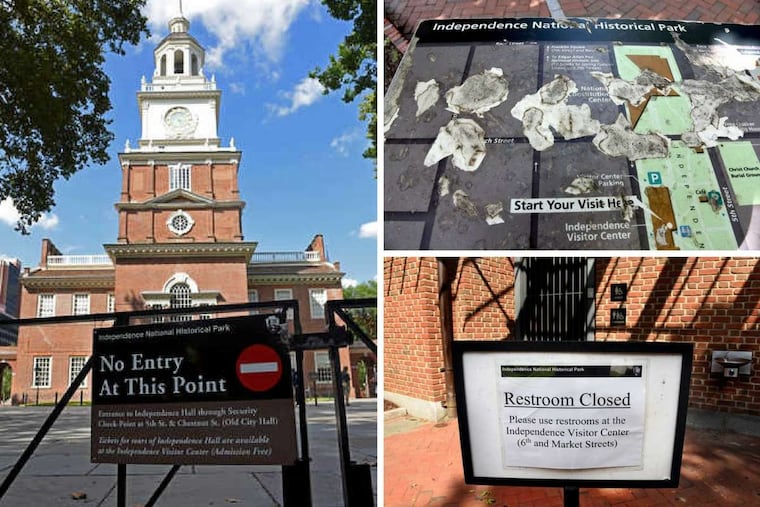Why do we tolerate the mediocrity of Independence Park? | Editorial
The park, designed to honor and celebrate the founding of modern democracy, is under stress.

Independence National Historical Park, designed to honor and celebrate the founding of modern democracy, is under stress.
The park – 33 historic buildings on 55 acres, whose centerpiece is the three-block grassy mall between Independence Hall and the National Constitution Center — is showing its wear.
A federal hiring freeze imposed in February has led to imprudent cuts in grounds crews and a maintenance backlog, an insult that hit just in time for the summer tourism season.
The grounds are weedy patchworks. Shrubs are unkempt, and the great lawn of the mall is a jumble of clover, broadleaf plantain, and bald spots.
Beyond the short-lived blooms of magnolia trees and roses, nearby squares lack color. The sight of broken branches, weeds, dying vines, and trash is not uncommon.
With the exception of the sleepy Fifth Street meditation gardens, the park grounds, and especially the mall, lack invitations to linger, like a children's play area or benches. Welcome Park, at Second and Walnut, is a forbidding stone hardscape with cracked marble markers. Metal security barriers circle Independence Hall like an ugly bracelet — and an uglier message of unwelcome in a place supposedly celebrating freedom.
Buildings in the park aren't faring well, either. Of the 33 historic buildings, only 20 are open during the summer, and fewer in winter. Declaration House, memorializing the home where Thomas Jefferson lived while writing the Declaration of Independence, is closed most of the time. The Bishop White and Todd Houses on Walnut are shuttered due to maintenance issues. So is the First Bank of the United States, founded by current Broadway star Alexander Hamilton. Incredibly, the public restroom at Fifth and Chestnut is locked.
Still, record numbers of visitors come to see it. Last year, the park received 5.1 million visitors. We suspect many of these visitors are drawn to the park for reassurance of the country's values rather than for a transformative experience.
The park's scope and standing are impressive. But the park should hold magic. It should be transcendent and exquisitely beautiful.
There is little overall cohesion to create a complete and inspiring experience. Consider the simple visual that ties Boston's Freedom Trail sites together — a two-brick-wide trail marker on sidewalks leading tourists to 16 sites. Independence Park's signage is inconsistent and jumbled. There aren't even obvious signs to direct visitors once they get off I-95.
Almost every day, school buses disgorge students near the Constitution Center. The young people make their way to the Visitor Center, then must race a brief traffic light across Market Street, where they confront long lines at the Liberty Bell but little else to engage their excitement or awe. Instead, they've arrived at a homework assignment.
Philadelphia – to say nothing of the country — has too much at stake to accept an uninspiring, somewhat unkempt park beset with a federal hiring freeze and a tolerance of mediocrity.
Independence Park should be a stunning salute to the most historical mile in the nation and a gateway to this vibrant region.
For years, the region's philanthropic and civic communities have, like the founders, shaped their own destiny by investing in the area. Though tired, the park area is a testament to the community's and former Mayor Ed Rendell's 1990s transformation of a dying city into a bustling tourist destination. Twenty years ago, a new Visitor Center, the Constitution Center, and the moving of the Liberty Bell were part of a major reboot of the park, and included a thoughtful mall redesign by landscape architect Laurie Olin. The city, state, and Pew Charitable Trusts, among others, took the lead. This season's opening of the new Museum of the American Revolution is a graceful note among the park's many sites of interest — which also includes the President's House, opened in 2010.
It's time to reimagine Independence Park. As democracy itself seems increasingly under stress, it's time to create an inspiring and uplifting experience that not only provides a coherent narrative of our founding, but inspires the next chapters of our democracy and our future.
That future should also include Philadelphians. For city residents, Independence Park is, according to one observer, the front parlor no one goes into. We may occasionally drag out-of-town relatives, but the rest of the time, residents avoid it — especially at night, when it's cloaked in darkness. This massive public space in the middle of the city should be an asset for all — a dynamic opportunity for residents and visitors to interact and engage with its riches and its principles.
We've created this project to challenge our readers and our leaders to start the next conversation about what Independence National Historical Park can and should be. As a "kickstarter," you'll find more than a dozen leaders' suggestions for improving the park, both big and small. In addition, we asked tourists on recent visits what they thought. We will revisit this subject often in the next few months, featuring other voices and ideas, and hosting public meetings. The park falls under the jurisdiction of the National Park Service, a beleaguered agency whose commitment to the place we don't doubt. But the park belongs to all of us. And it should reflect the audacity of the founders and the vitality of this city.